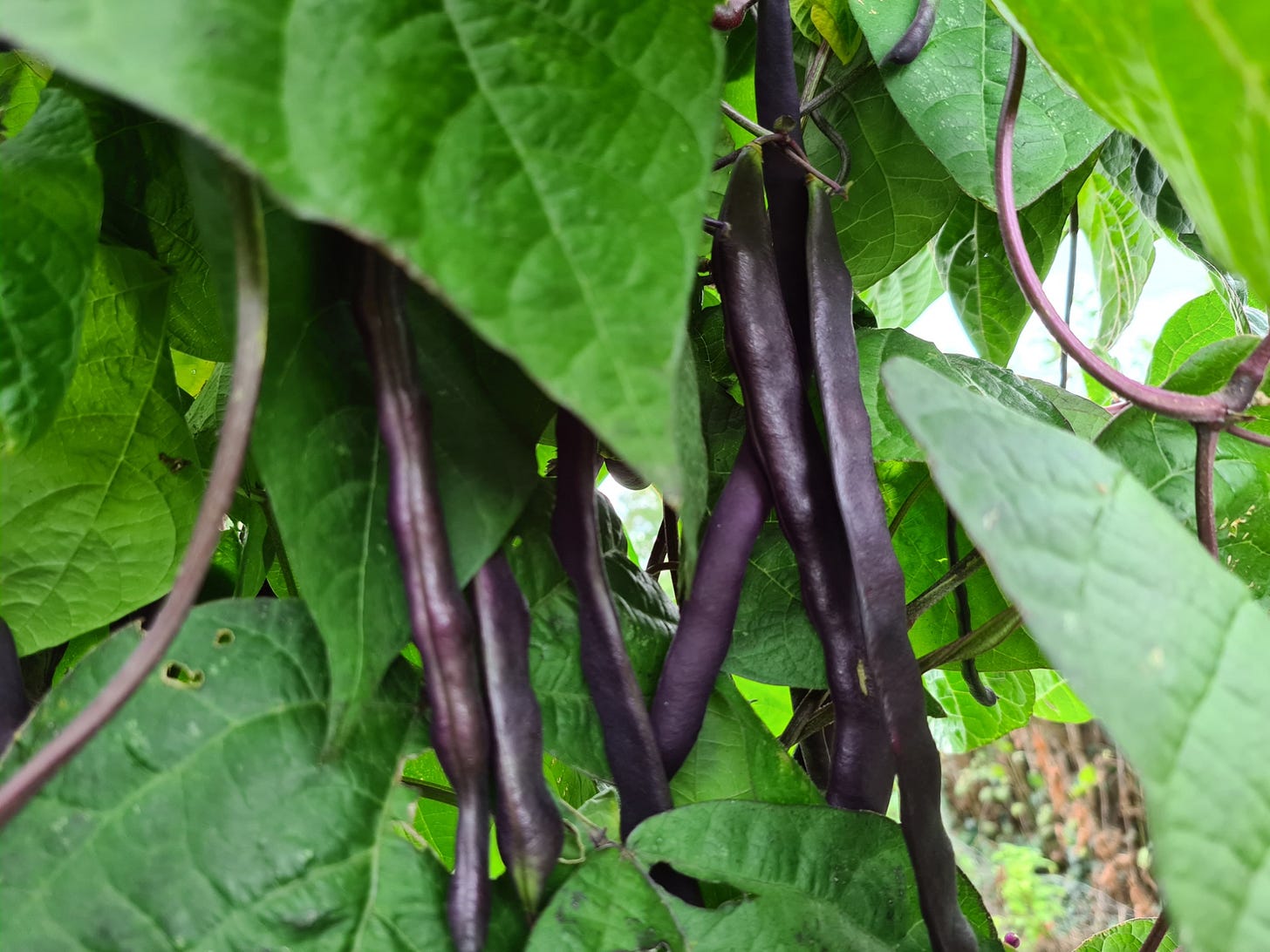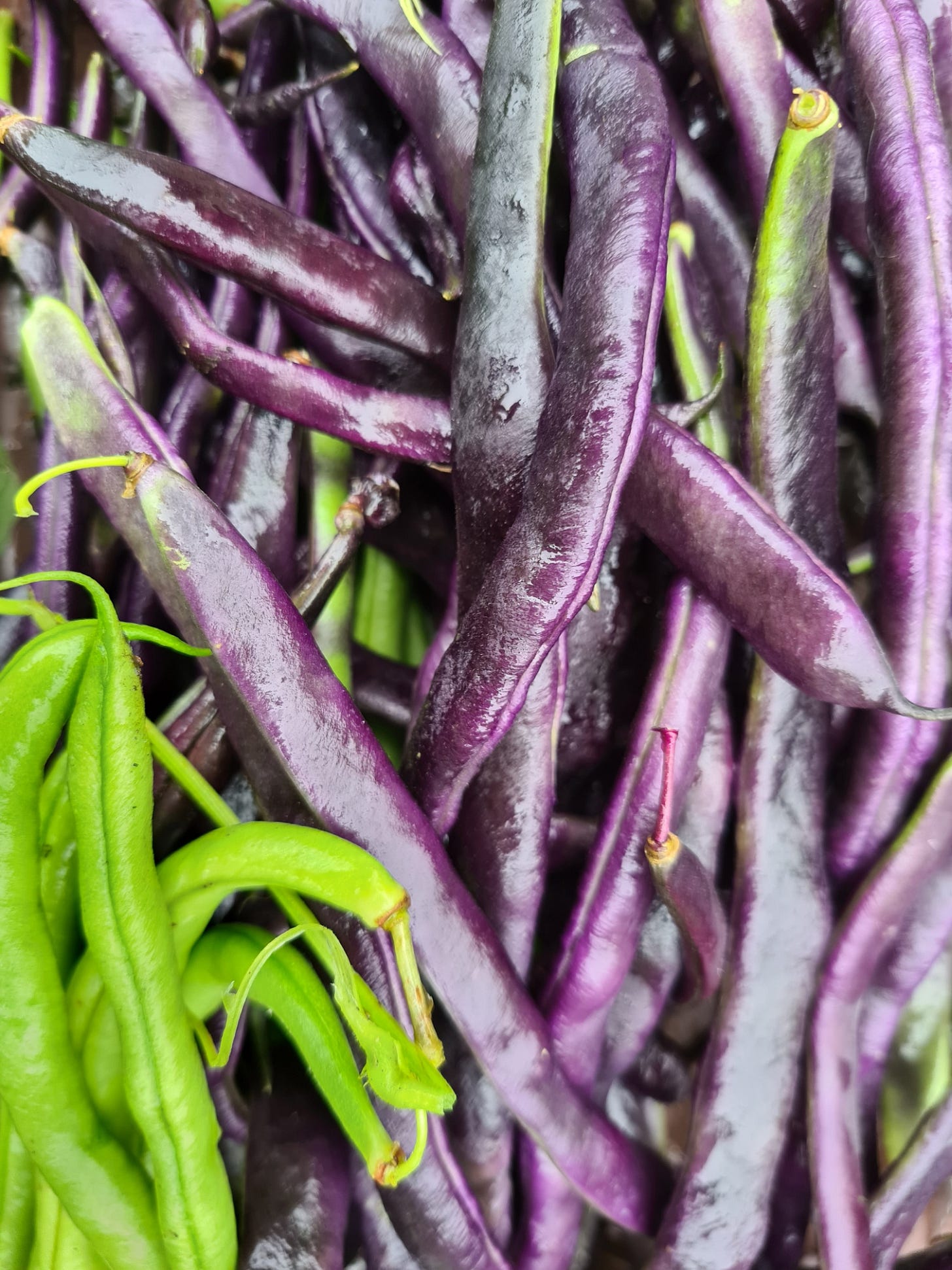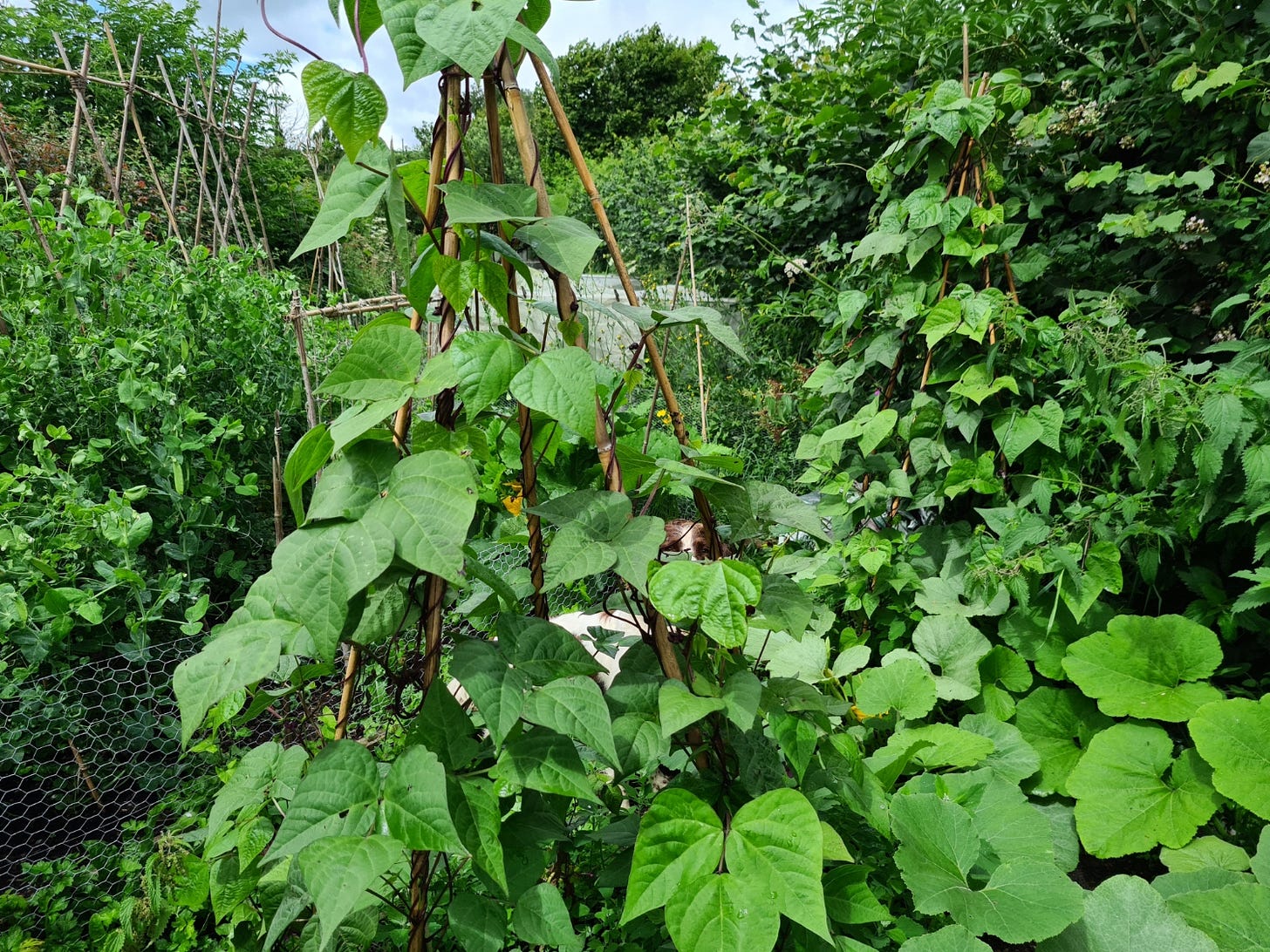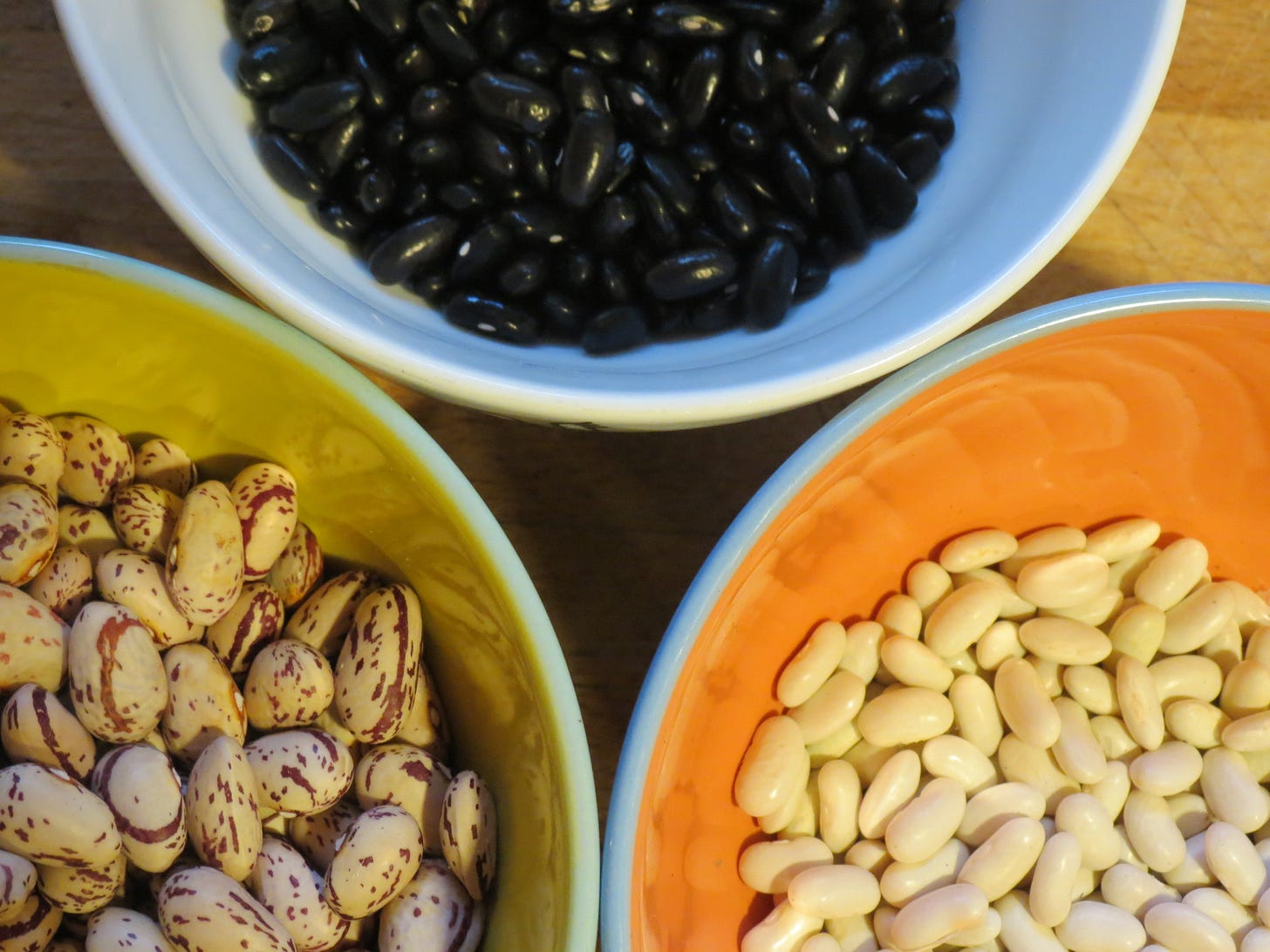The more you eat, the more you…. Oh for goodness’ sake. I wasn’t going to go there. I was actually about to make a finely gauged and sensitive point about how growing beans will indeed make your heart swell with joy, as they are among the prettiest and most productive things you can plant on your plot; and eating them is good for your heart in the medical sense, too. But then you had to go and take it into the gutter. Honestly.
Regular readers of Greenery will know that this year’s growalong is beans! Beautiful, jungly, flower-spangled, glossy, nutritious beans in every shape and size: and there are a *lot* of types to choose from. So many, in fact, that this is likely to become a two-year growalong: this year we’ll be exploring the wonderful world of climbing beans, while next year it’ll be the turn of shorter, stockier and hardier broad (fava) beans, Martock beans and the like, plus a few more ‘out there’ varieties.
There is a smattering of botanical, not to say geographical logic behind this division into beany camps. Climbing beans are from South America and belong to the botanical family Phaseolus, while broad beans and similarly low-growing, sturdy cousins like Martock beans are Middle Eastern and from the genus Vicia, an entirely different branch of the legume family. I’m also going to throw in (Chinese) soybeans next year as I’ve always wanted to have a go at growing them in the UK: that’s another branch of the legume family again, being Glycine max. And, just for fun, yardlong beans – another Asian bean from yet another genus, Vigna – and lablabs, from south-east Asia (Lablab purpureus, if you’re interested).
Incidentally this, right here, is why we have Latin in gardening. We refer to all these things as beans: but it takes quietly precise Latin to sort out the confusion and make sense of them all.
Anyway: that’s for next season. This year, we are all about the South American Phaseolus family, The long, slender, immature pods we know (inexplicably) as French beans have been popular in the Americas for around 5,000 years. So the story goes, they were brought to Europe by Christopher Columbus in the 15th, or maybe 16th century. A long time ago, anyway.
Since then beans have become such a staple of European cuisine that it’s hard to imagine a menu without them. Baked beans, haricot beans, kidney beans, green beans: this is the most versatile of foods. Beans can see you round the year in various different guises.
Their subtropical origins tell you a lot about what these plants need: warmth, a steady temperature (so no yo-yoing between day and night) and plenty of sunshine. They are really quite easy, and very rewarding to grow, producing lots of lush, satisfyingly jungly foliage and very generous harvests.
We’ll be going into the hows and whens of sowing and growing as we make our way through the season: but in the meantime, here’s a walk through the many different types of bean we’ll be growing this year. They’re all well worth some garden space: the difficult bit is deciding which ones to leave out!
French beans – climbing: aka green beans, aka pole beans (though this last term – an Americanism – also refers to any other climbing bean; runner beans would be pole beans, for example). They come in green, purple or golden yellow, and in two pod types: pencil-podded, which are very slim and cylindrical, and flat podded. Either way, they’re best picked young and sweet. You’ll need a good-sized (1.8m/6ft) wigwam of hazel rods by way of support, but if you have a large enough container – say 60cm across – they are easy-going enough to grow on your patio, too.
French beans – dwarf/bush: Very like French beans in terms of the range of pod shapes and colours available; but with an entirely different growth habit, as they reach about 60cm (2ft) tall then branch naturally into a bush shape. They mature and produce a harvest faster than climbing beans, so you can use them to extend the season; but the yield is lower.
Shelling beans: Leave any kind of climbing or dwarf French beans unpicked till the end of the season and the beans inside swell and mature fully into seeds. You can then dry and store these for many months: put a few aside to sow again next year, but eat the rest, as they make lovely filling, nutritious winter comfort food.
Some varieties produce particularly good seeds – either fatter, or prettier, or tastier, or all three. These varieties are grown mainly for the beans rather than the pods, which you can eat green but which often lack the flavour of podding varieties. Some – kidney beans, for example – are quite tender and need lots of warmth, so best in a greenhouse; others (haricots and borlotti beans) are much easier and can go in the garden alongside your other beans.
Runner beans: Not the same as French beans, but closely related, being Phaseolus coccineus rather than P. vulgaris (the coccineus means red and refers to the red colouring of the flowers).
Runners are a peculiarly British obsession: nobody else seems to grow them quite as enthusiastically as we do. Apparently that’s because in most other countries, summer days are too hot for runners to reliably set a crop (they are, however, grown for their lovely, ornamental scarlet flowers). Here in the UK where summers are still, mostly, quite cool, they are cherished for their exceptionally long harvesting window; runner beans start producing beans in July and are often still going strong in November. They’re also tender perennials, rather than annuals, so you can overwinter them – though I’ve always found they produce less prolifically the second year if you do. I’ll give this another try this year and see how we get on.
Full disclosure: I’m not that keen on traditional runner beans. They’re rough-skinned, and a bit stringy however young you pick them. So I gave up growing them some years ago in favour of much sweeter, more tender French beans. However: there’s a good compromise.
Self-fertile beans: This small but useful group of varieties are actually hybrids, a cross between runner beans and French beans. They crop for just as long as a runner, but they’re less stroppy and will still produce a harvest even in hot weather (runners tend to sulk till the rain returns). They’re also tastier, and not as stringy.
More on specific varieties next month, when I’ll let you know which ones I’ll be growing in my own garden this year in plenty of time for you to grab some seeds yourself and join me. This is going to be fun!








Thank you for this post, look forward to knowing which varieties you grow. Not had much success with bean growing - maybe this will be the year !
I have many packets of French beans and runners in named packets in my seed box in the “May” compartment but I’ve also got a jar in the kitchen of beans I managed to dry last autumn and this is a jumble of French beans and runners that I grew last summer. Some will end up in winter stews but I’m tempted to grow the unnamed ones next summer. For many years I didn’t grow runners but last few years I have so I have beans whether we have a full wet summer or a hot dry one. And in recent years I’ve become slightly obsessed with runners that grow dark purple pods instead of the green ones. HSL have been a wonderful source of these and although I didn’t save the names I can spot the purple pod runner beans in my mixed up jar of dried beans. Salford Black is a variety that I’ve tried before.